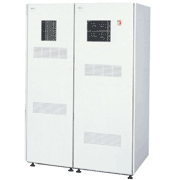The F6493 array disk unit*1 featured high availability using RAID-3 technology and fast access speeds by introducing larger cache memory and rotational synchronization technology.*2 Fujitsu began shipping the unit in June 1995.
- *1. The term “array disk” was used at the time, but eventually “disk array” would become the standard term.
- *2. Rotational synchronization technology is a function that synchronized the rotation of multiple hard drives connected in an array and equalized the rotational latencies. Combining this function with parallel access processing using data striping achieved device data transfer speeds of 20 MB per second.
Complete file systems could be constructed by connecting the F6493 to a F1710B file control unit.*3 Three models — the F6493G, F6493H, and F6493K — supported three different logical volume capacities — 1,260 MB, 1,890 MB, and 2,835 MB. The maximum recording capacity per unit for the F6493G was 80.64 GB, for the F6493H, 120.96 GB, and the F6493K, 181.44 GB.
- *3. The F1710B file control unit obtained the maximum data transfer performance from F6429 magnetic disk units with RAID functionality. The F1710B was furnished with three interfaces — an electrical channel, optical channel, and optical channel link (OCLINK) — to support as many server models as possible.
The F6493 used card disks,*4 which contained 3.5-inch hard drives, and high-density mounting technology to achieve per-unit storage capacities of 180 GB and file-system storage capacities of 720 GB while remaining energy and space efficient. The F6493 in a 64-drive configuration occupied one-third the space and used one-fifth the power of the previous F6427H model.
- *4. Card disk was a compact printed circuit board that contained a single hard drive and its connectors. Card disks could be inserted and removed from the F6493 unit for easy replacement of faulty hard drives while the unit was running. Card disks also increased the hard drive mounting density.
The F6493 also featured high reliability and high performance technologies: High reliability technologies: In the event of a drive failure, the faulty disk’s data were automatically recovered from a parity disk for service continuity. Another function automatically recovered data from a damaged drive to a hot-spare disk without any service impact whatsoever. And the card disk format allowed faulty drives to be replaced immediately without interrupting services.
High performance technologies: Combining technology that synchronized the rotation of multiple drives (rotational synchronization technology) with parallel access processing using data striping achieved data transfer speeds of 20 MB per second.
| F6493G | F6493H | F6493K | ||
|---|---|---|---|---|
| Initial shipping date | June 1995 | |||
| Storage capacities | Per unit | Basic configuration : 5.04 GB Full configuration:80.64 GB |
Basic configuration : 7.56 GB Full configuration:120.96 GB |
Basic configuration : 11.34 GB Full configuration:181.44 GB |
| Logical volume size | 1,260 MB | 1,890 MB | 2,835 MB | |
| Rank size (expansion increment) | 5.04 GB | 7.56 GB | 11.34 GB | |
| Track capacity | 47,476 bytes | |||
| Configurations | Ranks per unit | 1 — 16 | ||
| Logical volumes per unit | 4 — 64 | |||
| Logical volumes per rank | 2 or 4 | |||
| Drive-controller data transfer speed | 20 MB/s | |||
| Average positioning time | 10.3 ms | |||
| Average rotational latency | 5.6 ms | |||
| Data transfer speed | Specifications of the F1700 file control unit | 3.0 MB/s,4.5 MB/s |
|---|---|---|
| Optical channels | 6.0 MB/s,9.0 MB/s | |
| OCLINK | 12.0 MB/s,17.0 MB/s | |
| Number of channels | 4, 8, 12, or 16 | |


